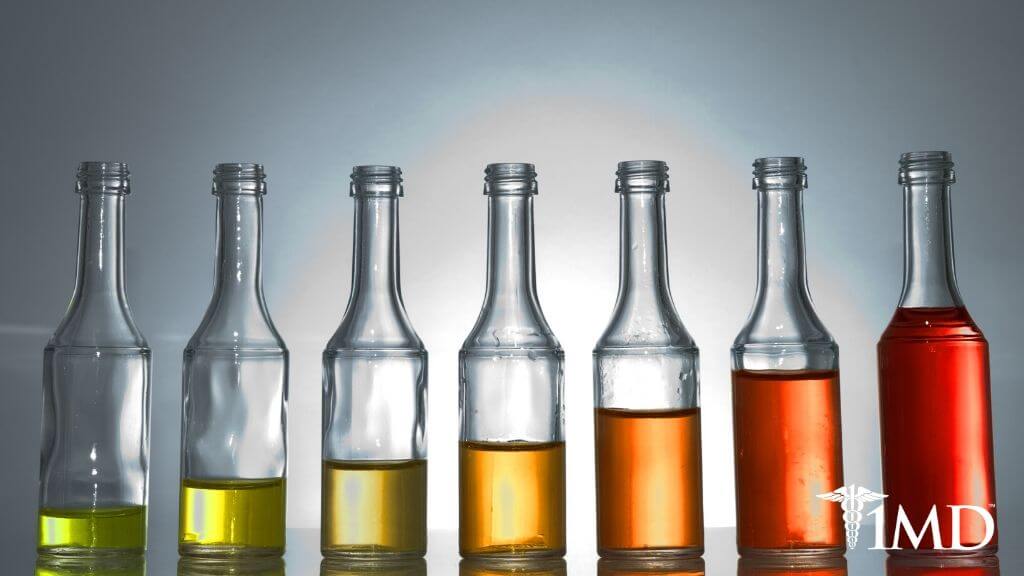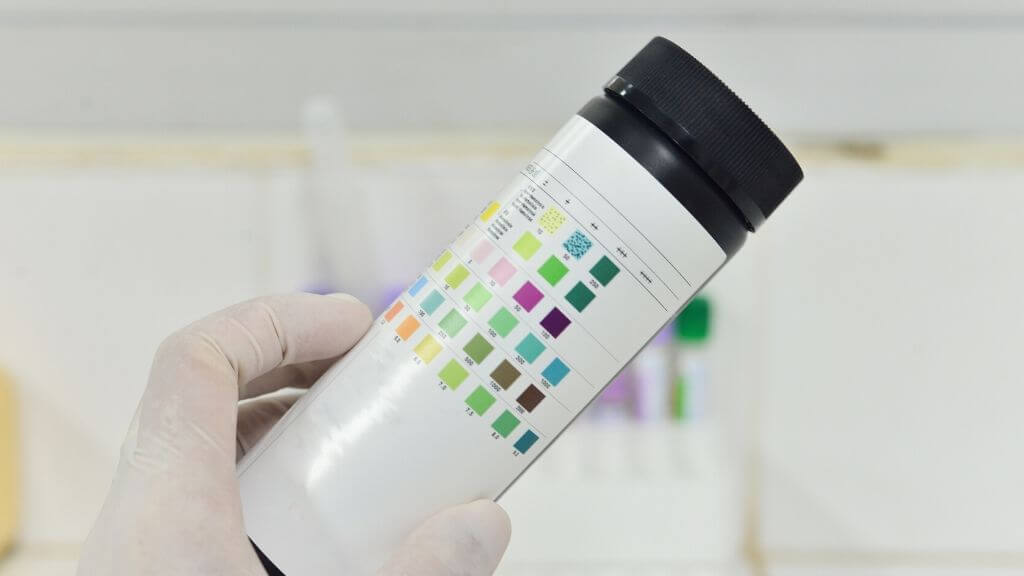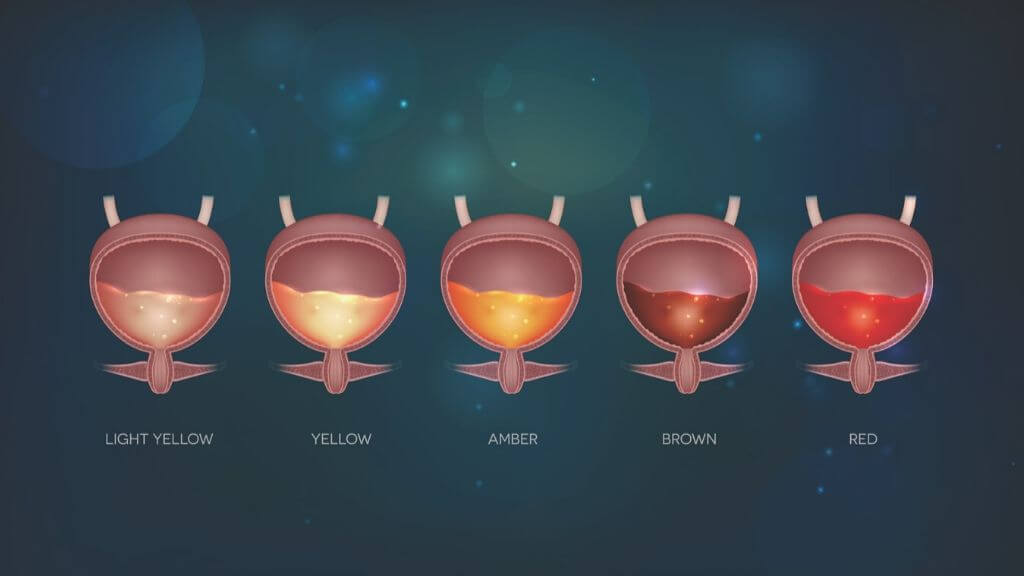Urine Color Meanings: Dehydration, Disease, and Drinking Water Tips
8 minute read
On average, we produce about six and a half cups of urine a day for a total of about four to eight trips to the bathroom. As such a routine part of our daily lives, you might not take much notice of the color of your urine unless it’s something other than yellow.
And it can become surprising colors, like brown, red, orange, blue, or green. Several factors can change the color of your urine, including food, medication, or underlying medical conditions.
First, let’s take a look at the normal range of color for urine and what makes it yellow to begin with.
Yellow: Light to Amber
Yellow, which can vary from very pale to amber, is what you’ll see most of the time.
The yellow color comes from urochrome, which is made when hemoglobin, the protein that carries oxygen in your red blood cells, is broken down.
| Related: The Weird Reasons for Brain Freeze, Hiccups, and More |
Generally, the higher the waste product-to-water ratio, the darker the urine, which means that the shade of yellow will depend on how much water you’re drinking and how diluted or concentrated the urochrome is.
Pale to yellow is normal, healthy, and means that you’re hydrated, whereas dark yellow or amber urine could be a sign of dehydration.
Orange
If you’re dehydrated, your urine could become dark enough that it appears to be orange. In this case, you simply need to drink more water and it will return to its normal place on the yellow spectrum.

| Related: Are There Microplastics in Your Water? |
Taking B-vitamins or vitamin C in large doses can turn your urine orange or a bright fluorescent yellow. These vitamins are water-soluble, so any excess is passed through your urine.
Excess beta carotene, which makes fruits and vegetables, like carrots and sweet potatoes, orange, can also lead to orange or bright yellow urine.
While usually just a matter of drinking more water or a result of your vitamin and supplement intake, orange urine can be a cause for concern. It could be a sign of liver dysfunction, especially if you also have pale stools.
Brown
Food can also cause brown urine. These foods include large amounts of fava beans, aloe, or rhubarb.
Some medications could also be the culprit, including antimalarial drugs like chloroquine and primaquine, the antibiotics metronidazole and nitrofurantoin, laxatives that use cascara or senna (which can also cause red urine), and the muscle relaxant methocarbamol.
As with other changes in urine color, brown could indicate that you have a liver or kidney disorder, or a urinary tract infection (UTI).
In extreme cases, dark brown urine can be caused by rhabdomyolysis, which is when muscle fibers die and their contents move into the bloodstream. Rhabdomyolysis has many causes, which include a crush injury, snake venom, infection, heat stroke, and extreme muscle strain.

| Related: 12 Things Your Poop Says About Your Health |
Rhabdomyolysis can lead to kidney failure and, in rare cases, death, so talk to your doctor if you think that it maybe linked to the color of your urine.
Red
Pink or red urine may mean that blood is present, but it isn’t always the case. Look first to what you’ve eaten recently, which may have caused the change in color. Foods like beets, blackberries, and rhubarb can add a red tint, though this only occurs in about 10% to 14% of people.
Rifampin, phenazopyridine, chlorpromazine,thioridazine, and laxatives that contain senna are examples of medications that can turn your urine a reddish orange.
If food or medications aren’t the cause, then it could be blood. Blood in the urine (hematuria) isn’t always cause for immediate concern, though it can be an indicator of something serious.
Blood can leak into your urinary tract due to a variety of issues. These include UTIs, an enlarged prostate, kidney cysts, kidney infection, kidney or bladder stones, strenuous exercise, or damage to the upper or lower urinary tract.
More serious medical conditions are rare, but blood in your urine could be caused by bladder cancer, kidney cancer, or another kidney disease.

Hematuria can happen to anyone, but there are a few factors that puts you at higher risk:
Age: Men over 50 are more likely to have an enlarged prostate.
Recent infection: Kidney inflammation can happen after a viral or bacterial infection.
Family history: A family history of kidney stones or kidney disease could increase your chances of hematuria.
Medications: Blood thinners like aspirin, nonsteroidal anti-inflammatory pain relievers, and penicillin increase the chance of bleeding in the urinary tract.
Strenuous exercise: Though what exactly causes it is unknown, strenuous exercise and long-distance running can lead to hematuria.
Check with your doctor if your urine suddenly becomes red for an unknown reason or if there is visible blood.
Blue or Green
Blue or green urine is definitely a surprise, but the cause can be as simple and benign as dyes. The dye could come from food or from medical tests for your kidneys or bladder.
| Related: 10 Reasons Why Bee Pollen Is a Superfood |
Medications can also be a cause for blue or green urine, which include amitriptyline, indomethacin (Indocin, Tivorbex), and propofol (Diprivan).
In children, blue urine can be caused by the rare inherited disorder familial benign hypercalcemia, or blue diaper syndrome. In this case, the blue color is the result of an inability to fully break down and absorb tryptophan, a dietary nutrient.

Asparagus, which most famously can make urine have a particular, unpleasant odor, can also give it a green tint.
Green urine also might be a sign of a UTI, specifically ones caused by pseudomonas bacteria.
Cloudy or Murky
Cloudy or murky urine can be a sign of a UTI or kidney stones.
Symptoms of a UTI also include frequent urination, pain or burning when urinating, fever, and difficulty emptying the bladder.
You might have a kidney infection or kidney stones if you also have a strong, persistent urge to urinate, there is blood in your urine, and pain in your back, side, lower abdomen, or groin.
The Bottom Line
Urine isn’t always yellow. In fact, it can be a variety of colors from red to green. While food, supplements, and medications can be the cause of a change in urine color, underlying medical conditions could also be to blame.
Talk to your doctor if you experience any sudden, prolonged, or unexplained urine discoloration.












